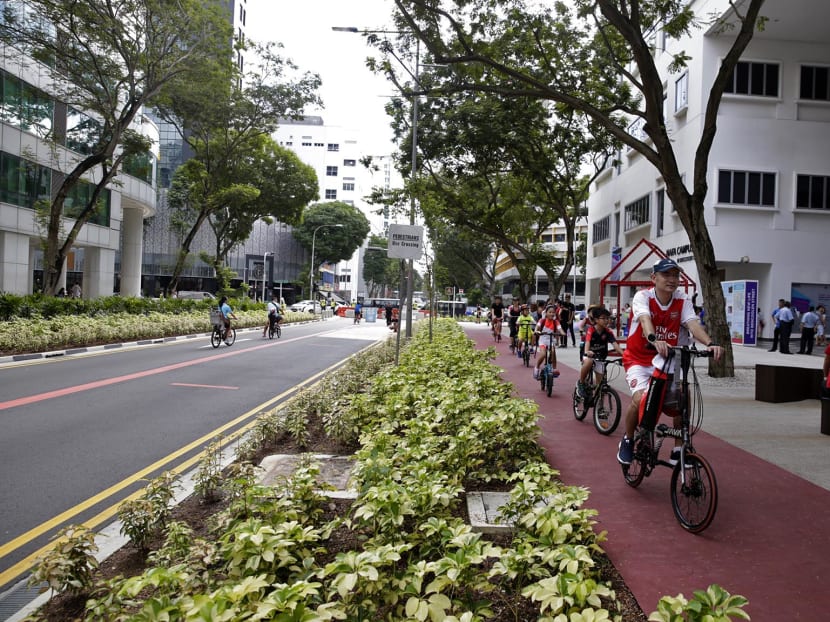Cycling network for central Singapore in the works
SINGAPORE — An extensive cycling network that connects the central part of Singapore with housing estates with the heartlands is in the works to boost the Republic’s vision of going car-lite. And traffic lanes of some roads will have to go as a result.
SINGAPORE — An extensive cycling network that connects the central part of Singapore with housing estates with the heartlands is in the works to boost the Republic’s vision of going car-lite. And traffic lanes of some roads will have to go as a result.
This will extend the Marina Bay cycling network to areas such as the Central Business District, Civic District and Bras Basah, with road space to be converted into cycle lanes and wider pavements for pedestrians.
A tender will be called in the coming months for the design and construction of the proposed network, which will be linked to cycling routes round the island, including the Rail Corridor, North-South Corridor and the Queenstown-city and Bishan-city routes.
The Land Transport Authority and the Urban Redevelopment Authority (URA) shared these plans at Car-Free Sunday (May 28).
It was the first edition of the event that included the revitalised Bencoolen Street, which has had two of its four original car lanes converted into walking spaces and a cycle path connecting Bras Basah MRT Station with the upcoming Bencoolen station.
The 450m street also features benches designed by students and alumni of the Nanyang Academy of Fine Arts (Nafa).
To encourage more people to commute on two wheels, more than 125 bicycle parking lots have been installed along the street, such as at the entrances of the coming Bencoolen MRT Station, Nafa, V Hotel and Bayfront Hotel.
Elsewhere in the city, one side of Anderson Bridge has been pedestrianised to create a gateway to the arts and cultural precinct.
The bridge straddles the Singapore River and connects Collyer Quay with Empress Place, which includes several museums and performing arts venues.
Over the next three years, Armenian Street, Coleman Street and Waterloo Street will be transformed to support the car-lite vision.
Part of Armenian Street, for instance, will be fully pedestrianised and converted into an urban park managed by the National Parks Board. Coleman Street and Waterloo Street will each have one car lane reclaimed for wider sidewalks.
Shared paths for cycling and walking will be incorporated along Coleman Street and Armenian Street to form part of the proposed central area cycling network.
The enhancement works are expected to begin next year and will be completed progressively by 2020.
URA senior director (urban design) Andrew Fassam said creating well-connected, pedestrian-friendly areas is a cornerstone of the plans for the city centre.
“It’s not feasible to keep building roads,” he said. “These projects help to demonstrate the confidence that we don’t need to continue to rely on cars and private transport.”
Transport analyst Lee Der Horng, from the National University of Singapore’s engineering faculty, said the initiative to convert car lanes into sidewalks and cycle paths mirrors international trends.
Echoing the call for a car-lite society, he said: “Our city has previously been built to accommodate a lot of vehicles, and it’s time for a change in mindset. I think Singaporeans will be responsive to this change.”
Prof Lee noted that the streets to be transformed in the central area serve as important activity nodes.
He urged the planners to be mindful, however, of ensuring cycling connectivity to the heartlands, as users would want to ride to their workplaces and schools, “not just for exercise or leisure during the weekends”.
“The key word is ‘network’,” he said.
An avid cyclist and participant in the Car-Free Sunday event who wanted to be known only as Mr Goh hopes that the infrastructural developments will facilitate more gracious behaviour on the roads.
“Changes to infrastructure are a means to a larger goal and a more inclusive society,” said the 29-year-old, who cycles for leisure and to work.
Another cyclist, Mr Lim Chee Keong, 52, called for more public education: “Often, as we ride on pavements and cycle paths, we come across people standing in the middle of these paths. So the awareness of safety is still not there for some.”
Taxi driver Dennis Lau said the reduction in vehicular lanes may worsen traffic conditions in the city during peak hours: “It’s better for them to close the whole street and convert it into a park than to convert a few lanes.”







